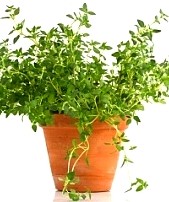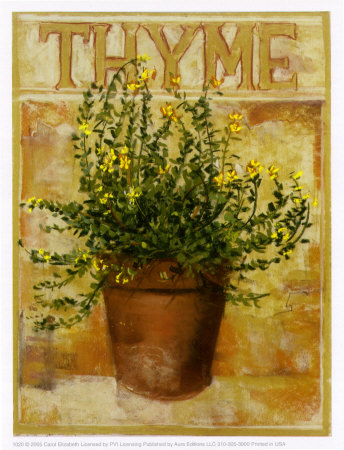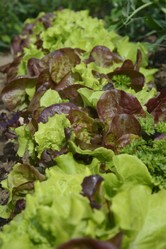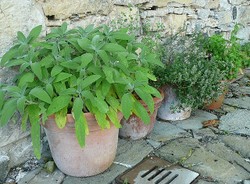Thyme warrants a special place in any garden and indoors on the windowsill in a sunny spot. Its foliage is very attractive, its lovely flowers are long-lasting, its leaves can be picked for a highly versatile herb, and it forms a compact easy-care attractive low shrub in the garden. It grows from seeds easily indoors in pots, and this is the way to grow seedlings for outdoor plantings.

How to Grow Thyme Indoors and Outdoors from Seed
by janderson99
Learn how to grow this beautiful perennial low shrub that will reward you with delightful flowers and a bountiful yield of aromatic leaves for your cooking.
Its Time for Thyme!
Thyme is a renowned Mediterranean herb that imparts its beautiful flavor and aroma in a variety of cooking recipes and styles. Thyme blends well with the other major flavors of the region - olive oil, garlic and tomatoes. Thyme is also considered to have preservative and antiseptic properties and has long been used in various home remedies as well as helping to preserving meats. Thyme extract is even used in perfumes. This article will help you grow this wonderful fresh herb at home so that you will always have some available for cooking.
Growing Thyme
Thyme is a somewhat woody, low growing perennial. There are about 350 different species with very sizes and forms including cascading form species that are ideal for overhead pots. It is extremely fragrant and flavorful plant that grows well even in dry and in tough conditions. The lavender, pink, yellow or white tubular flowers are loved by bees and butterflies. The tiny aromatic gray-green leaves remain evergreen. Thyme can be used as an edge plant, and even a low hedge along a garden bed. However plants can die out occasionally, so you need to be prepared to replace these with new plants. Thyme is native to arid regions and grows best when left alone. Don't over water the plants, as this is one of the major problems when you first start to grow them. They only need water once a week or fortnight. Plant them in places where they won't get the over-spray from watering other plants or 'wet feet'.
 | Nature's Blossom Herb Garden Seed Starter Kit. Grow 4 Herbs from Organic Seeds - Basil, Cilantro,... Nature’s Blossom's Herb Garden kit offers everything you need to grow 5 delicious culinary herbs from seed in one gift box.There's nothing like the taste of fresh herbs that wer... |
 | Fiber Soil (12 Quarts) Organic Potting Soil + Hydrating Bag = Healthy Plants. for Planting Indoor... Fiber Soil is the smarter choice: Plants Grow Better- The natural fiber absorbs up to 10 times its weight in water, providing more water and nutrients to plant roots. And, becau... Only $12.99 |
 | AeroGarden Black Harvest, 2019 Model The AeroGarden Harvest is a simple, beautifully designed garden, versatile enough to fit almost anywhere, but perfect for the best room in the house your kitchen. The Harvest is... |
 | 10 Variety Culinary Herb Collection and 96 Page Growing Guide - Non GMO Heirloom Basil, Thyme, Ro... Most POPULAR GOURMET herbs:Basil, Chives, Cilantro, Dill, Lavender, Oregano, Parsley, Rosemary, Sage, and Thyme!***Some of the above varieties of seed may be substituted, but ar... Only $12.99 |
 | CedarCraft Elevated Spruce Planter (21" x 47" x 32"H) + Greenhouse Cover & casters - Complete Rai... Perfect for patios, balconies or backyard gardening. Grow tomatoes, vegetables, herbs or your favorite flowers anywhere. Elevated planters let you garden in comfort alleviating ... |
Where to Plant
Thyme can be used as a ground cover plant in a dry sunny area and in rock gardens. It can even be grown in the cracks between rocks and pavers where it yields a delightful aroma when you tread on the plants. Some people buy lots of seed in bulk to make a thyme lawn. The special trailing varieties look wonderful in pots, especially the variegated and golden varieties.
Indoor herb seed planting - Plant the thyme seeds using the directions on the pack as some varieties vary in their requirements. Use a more sandy, high quality seed-raising mix for growing the seeds. Plant a handful of seeds well spaced in each pot, water thoroughly and cover with plastic. Use less seeds if the plants are to be grown permanently in the pot. The seedlings can be transplanted into outdoor area once they have developed sufficiently. Covering the pot with a piece of plastic seems to help germinate the plants quicker, and less watering is required. It generally takes about 7-10 ten days for the seedling to appear (depending on the temperature). When the plants have developed two or three true leaves, they can be thinned out leaving 8 - 12 inches (20 - 25 cm) between the seedlings. The seedlings can be transplanted outdoors when a little more developed.
Try to choose a sunny, and warm spot for your pots of seedlings after they appear. Thin out and retain the healthiest and more vigorous plants. Only water when the surface soil is dry and make sure you test the soil moisture before over watering.
Outdoor Plantings of Thyme Seed and Seedlings
Choose a relatively dry and well-drained location with full sun exposure and light sandy soils that will drain well. When directly planting seeds, mix some sand into the garden soil to get a drier soil for initially growing the plants. Seedlings grown in pots indoors can be easily transplanted into outdoor locations. Allow about 9 inches (20 cm) between seedlings, and thin seedlings growth from seed to this spacing. Thyme will do in very sunny spots where most other plants won't grow, but avoid shady and wet spots. Thyme grows well in large pots outdoors and looks wonderful in hanging baskets, using the trailing varieties.
Guide and Tips for Growing Thyme
Soil and Location for Planting Thyme => Choose an area with light, well drained soil, in full sun.
Time Period from Planting to Harvest => If grown from seed the growth takes about about 12 months, if splitting plants in about 6 months. Thyme also grows well from stem cuttings and these take about 9 months to grow. Don't be tempted to pick the leaves too early from young plants as this could slow down the development of the plants.
Thyme Size and Form => Thyme plants grow to a height of about 30 cm (12in) depending on the variety and are best suited to a rock or low herb garden, along a garden edge of a path, or along the front border of a garden bed. Plant a clump of plants so that you have harvest the group all the time without damaging individual plants.
Where To Grow => Thyme likes a well-drained and light soil as it originated in a dry harsh environment. It the soil is too rich in nutrients the plants will become 'leggy' and will lose their normal compact shape. They need a warm position in full sun.
Propagation => Thyme can be grown in a variety of ways - root division, from cuttings and from seed, but growing from seed will take 12 months. The quickest and best way is to get some roots from a friend or neighbor. In that way you will know that the plants will grow in your area and what the will look like. Stem cuttings work but are hard to do. When starting thyme from seeds, fill a pot with a sandy seed-raising mixture. Sprinkle a handful of seeds over the surface, and just cover them with the potting mix. Cover the pot with a little plastic and water sparingly until germination in about one week. To divide the roots of an established plant - dig it up in late Spring, when the soil is dry, and brush away much soil as possible from the roots. Gently prise the plant apart into three or four pieces. Each of the parts should have both roots and foliage. Once divide the parts can be simply replanted in the ground. They will be ready for moderate level harvesting in about 6 months.
Soil Requirements => Light, well-draining soils that are not too rich. Thyme can be grown in pots in a variety of soils and various soil-less potting mixes that include vermiculite, perlite, rockwool, coco peat and a variety of other organic material sources.
Care of Plants => Thyme requires very little maintenance and little watering except in very dry conditions. Feed with nutrients sparingly, and apply a good mulch of well rotted organic matter each spring.
Expected Useful Life => Thyme will become less prolific for harvesting leaves and tend to become woody after 3-5 years. Plants should be divided as described above, and replanted to encourage new growth to develop. Or the old plants can be replaced.
Harvesting => The Thyme leaves can be harvested right throughout the year, although summer is the best time for the full flavor in the leaves. In cold climates the plants stop growing in winter and so harvest sparingly. The thyme sprigs harvested in summer can be frozen or dried and used throughout the winter months.
Pests and Diseases => Thyme is virtually free of pests and diseases, although some insect pests can be troublesome at times.
Gardening News
You might also like
Silphium RediscoveredA highly prized culinary herb has almost certainly been discovered, even thou...
Five Useful Herbs for Your GardenThinking of starting a herb garden? Choose these five useful herbs to get goi...





 Google's Secret Traffic Share Quotaon 10/18/2014
Google's Secret Traffic Share Quotaon 10/18/2014
 Starting a Garden : What Tools do You Really Need?on 04/28/2012
Starting a Garden : What Tools do You Really Need?on 04/28/2012
 How to Make Eggplant Parmigiana at Homeon 04/27/2012
How to Make Eggplant Parmigiana at Homeon 04/27/2012
 Homemade Potato Salad Recipes - German, Baked, Boiled, Red Potatoeson 04/24/2012
Homemade Potato Salad Recipes - German, Baked, Boiled, Red Potatoeson 04/24/2012



Comments
I love cooking with fresh herbs, thanks for the tips on growing thyme indoors. I always like adding living plants to my kitchen.